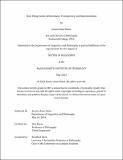| dc.description.abstract | The principles at the heart of this dissertation are Arbitrariness and Transparency. A representation is arbitrary with respect to content to the extent that the vehicle of representation (brain states, phenomenal experiences, pen marks, soundwaves, etc.) could have represented different content. A representation is transparent if one can be aware of the content of the representation in virtue of hosting it, without being aware of the representation itself.
Chapter 1 argues that visual phenomenal character is fully arbitrary with respect to the objects of perception. That is, for any visually perceptible set of objects and any visual phenomenal character (any ways things perceptually seem) there could be a veridical perception of exactly those objects with that character. This principle is rejected by almost all contemporary theories of perception, yet rarely addressed directly. Many have taken the apparent inconceivability of a certain sort of “shape inversion” — as compared to the more plausible, frequently discussed “color inversion” — as evidence that the spatial characters of our perceptions are uniquely suited to and/or revelatory of the structure of their objects, such that alleged perceptions of those objects that differed radically in spatial character could not be veridical. I argue that these conclusions are unjustified: I claim that the difficulty involved in constructing coherent “shape inversion” scenarios is attributable to the complex relations among visual and tactile shape experiences, as opposed to relations between shape experiences and worldly shape properties.
There is a consensus that endorsing the arbitrariness of perception — as defended in Chapter 1 — necessitates rejecting the transparency of perception with respect to worldly objects. Chapter 2 attacks that consensus. The consensus requires positing a family of properties whose metaphysical status is much more peculiar than is generally appreciated. These “noumenal” properties are allegedly essential to explaining the veridicality of our perceptions, yet no clear explanation is available for how we can learn about them or why we should postulate them. I argue that they do not exist.
Chapter 3 defends an empiricist constraint on understanding language. I argue that the arbitrariness of language prevents anyone — regardless of intelligence, access to data, etc. — from understanding the meaning of words merely by learning how words relate to other words or other arbitrary symbols. While Chapter 1 argues that perception is arbitrary with respect to objects, perception is not arbitrary with respect to perspective-indexed contents. It may be arbitrary how the pen looks insofar as it is arbitrary who is doing the looking, but it is not arbitrary how the pen looks to me or to you. Given what the pen is like and given what I am like, there is only one way for the pen to look to me. I thus argue that one can only understand language by associating at least some linguistic expressions with perceptual representations of parts of the world described by those expressions. If this view is correct, then all knowledge of the world necessarily relies on foundational knowledge about how the world perceptually seems to the knowers. | |
